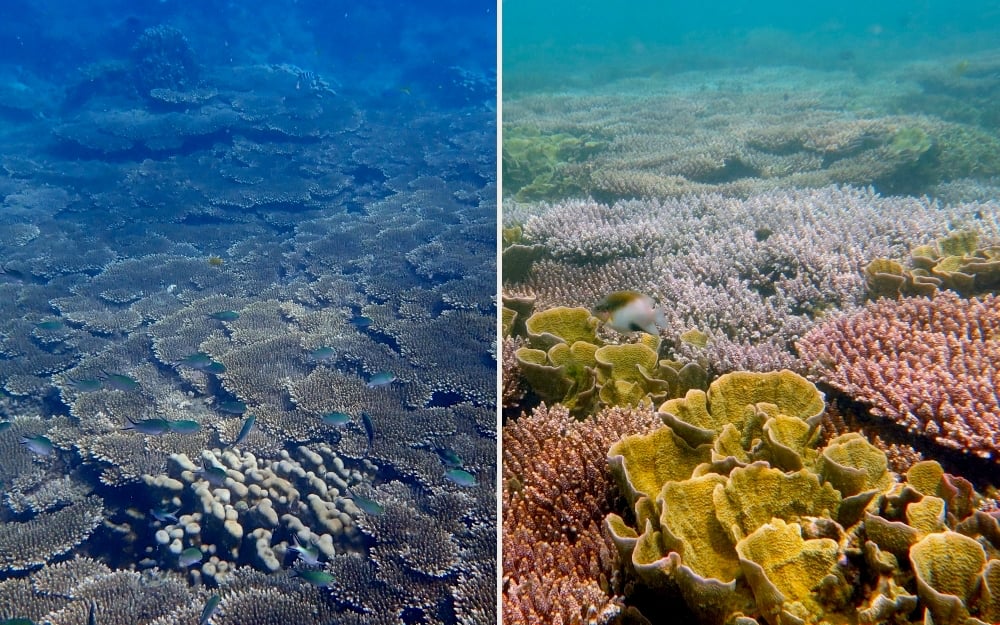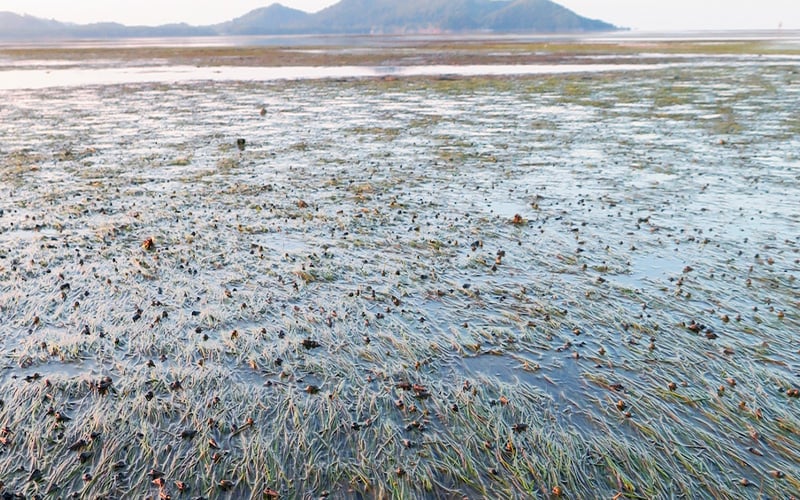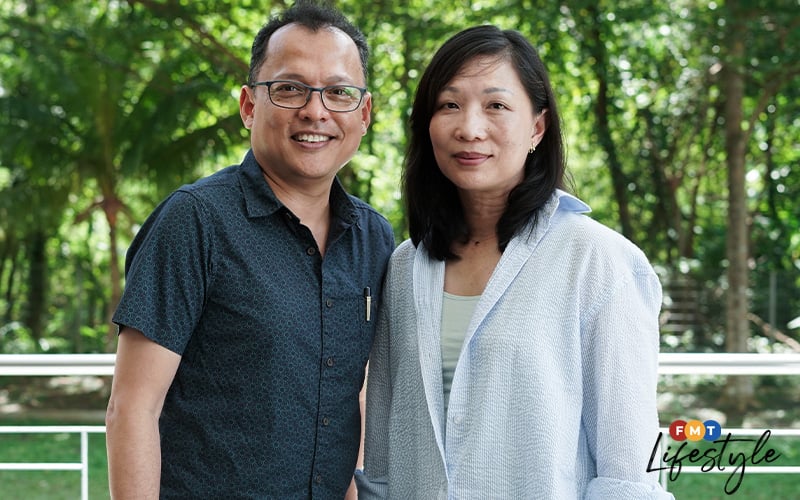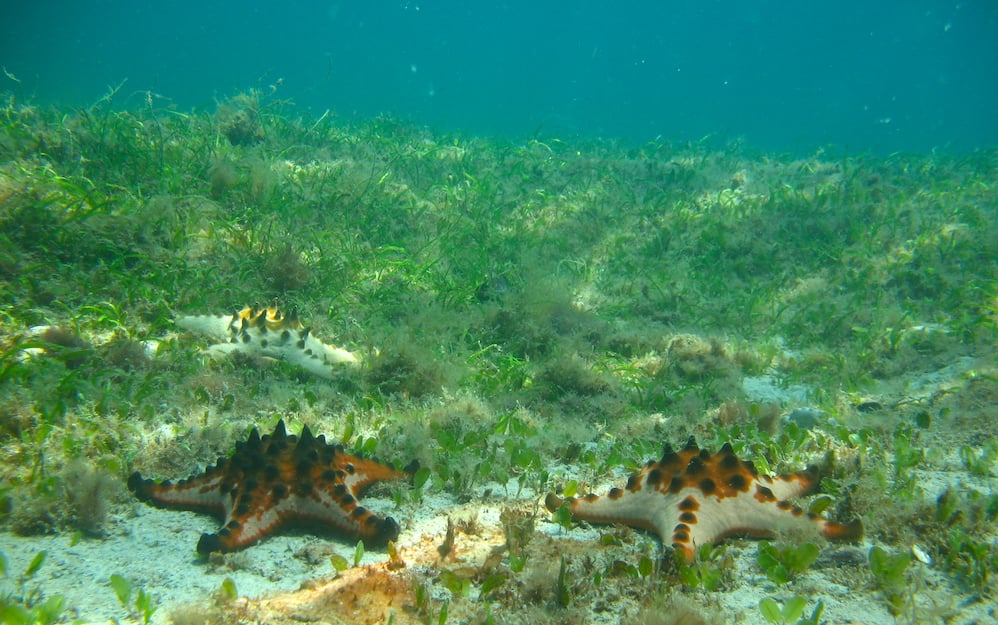
Seagrass, coral reefs, and their importance to the marine ecosystem
FMT speaks with husband-and-wife team Jillian Ooi and Affendi Yang Amri about their passion for these crucial natural resources.

An intertidal seagrass meadow at Pulau Sentidan, Johor, exposed during low tide. (Jillian Ooi pic)
PETALING JAYA: When one imagines the azure sea, beautiful coral reefs may come to mind. But what about seagrass?
You can’t be blamed if you haven’t heard of seagrass meadows, which are distinct from coral reefs; not many people have. Yet, both play crucial roles in the marine ecosystem and, according to seagrass expert Jillian Ooi, there is more to this underwater flowering plant than meets the eye.
“They provide a home and feeding ground for many marine animals such as green turtles, dugongs, and seahorses,” Ooi, a senior lecturer at Universiti Malaya (UM), told FMT.
“This rich marine life is actually one of the main reasons people come to Malaysia for ecotourism.”
Affendi Yang Amri of the Institute of Ocean and Earth Sciences, a research facility at UM, added that people are more familiar with coral reefs because “they’re beautiful, are associated with clear waters, and have a lot of multicoloured fishes”.
In truth, many marine creatures start their life cycles in seagrass beds. This was something the duo observed when they supervised a project by one of their postgraduate students, who used GoPro cameras to record the types of fishes in seagrass meadows and coral reefs.

Scientist couple Affendi and Ooi are passionate about marine ecology and the communities that depend on them. (Tinagaren Ramkumar @ FMT Lifestyle)
“We realised there were a lot of juvenile fishes among the seagrass, and that they move from seagrass meadows to coral reefs when they are larger. This is why we call seagrass the ‘kindergarten of the sea’,” Ooi shared.
She said many of the vibrant fish from coral reefs go to the aquarium trade, while those in seagrasses – such as snapper and emperor fish – are often caught and consumed by humans.
Speaking with the husband-and-wife pair, it’s hard not to notice their passion for their underwater subjects. Affendi’s love for the marine world started at a young age, through “National Geographic” magazines and Jacques Cousteau documentaries.
Ooi’s interest in seagrass, meanwhile, stemmed from the couple’s first project together, during which they studied dugongs. “It’s what dugongs eat, and that’s when it really struck me how important the seagrass ecosystem is.”
Her other love is music: Ooi is the artistic and music director of Rhythm in Bronze (RiB), a local contemporary gamelan ensemble. In August, RiB is slated to stage a production featuring original compositions about seagrass and the communities that depend on them.

Coral reefs could disappear in the next 20 or 30 years owing to climate change and other threats. (Jillian Ooi pics)
The latter is something Ooi is particularly passionate about. “Seagrass meadows are where the hardcore poor in coastal areas go to get food as there are no other options for them on land. They can’t do gardening if the land isn’t theirs,” she pointed out.
These communities, therefore, depend on such meadows for animal proteins such as fish and crabs. This is done during low tide, when “intertidal meadows” are exposed: large expanses of seagrass that trap certain fauna.
The villagers then walk out into these meadows to collect the creatures for consumption. “Where else would they get their food from if they have no money?”
Ooi and Affendi also hope to raise awareness on the threats faced by maritime ecosystems. According to Affendi, coral reefs are usually the first to be affected by significant impactors to the environment such as climate change.
“These reefs are in danger, and there is a high chance they’re going to disappear in the next 20 or 30 years,” he said.
Then there’s water pollution, a clear and present danger as coastal areas increasingly undergo development.

Though easily eclipsed by more striking-looking marine life, seagrasses are beautiful in their own way. (Jillian Ooi pic)
“When untreated sewage goes out into the ocean, it causes diseases and algae bloom,” Ooi said, referring to rapid increase or accumulations of algae in freshwater or marine systems.
“Algae is seaweed, which grows much faster when it gets nutrients from sewage, fertilisers, or pollutants in general. They then will outgrow both the corals and seagrass.”
Furthermore, ill-planned development and land-reclamation projects threaten the undersea ecosphere. As such, Affendi hopes developers will engage with marine ecologists to minimise disruption to seagrasses and reefs.
For Ooi, education is key. “Our public education system does not provide schoolchildren with meaningful experiences of nature. Students shouldn’t be confined to classrooms.
“Teachers are also stretched because of funding issues, which, in the long term, will change the face of conservation and environmental protection as only the wealthy will be able to do it.”
Affendi concludes that parents have a significant part to play. “Bring your children out to experience nature and help them understand why it’s important,” he said.
“Then, hopefully, the younger generation will realise how beautiful and vital nature is.”
Environment Ocean
Comments
Leave a comment in Nestia App